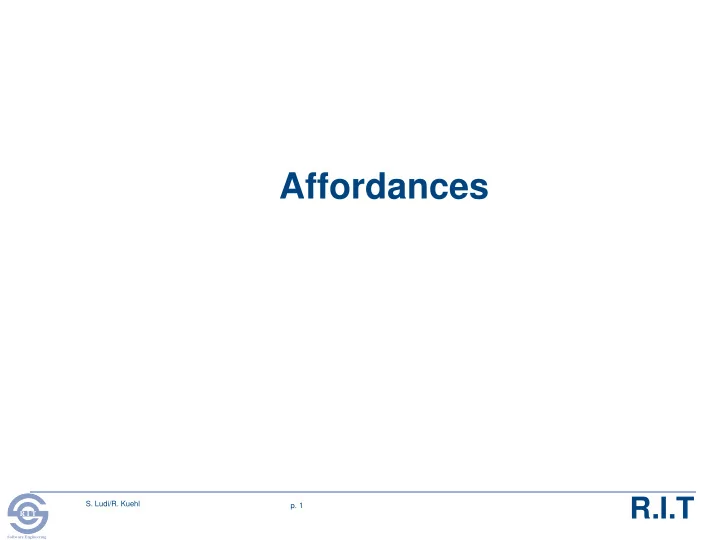

Affordances R.I.T S. Ludi/R. Kuehl p. 1 R I T Software Engineering
The Design Challenge “Don’t Make Me Think”, Steve Klug R.I.T S. Ludi/R. Kuehl p. 2 R I T Software Engineering
What is an Affordance? “ To afford ” means to offer, yield, provide, give, furnish, help, or aid Psychologist James Gibson, “Theory of Affordances”, 1977 article R.I.T S. Ludi/R. Kuehl p. 3 R I T Software Engineering
Semantic and Articulatory Distance Semantic Distance Mental distance between what people want to do and the meaning of interface elements (Conceptual and semantic levels) Articulatory Distance Mental distance between an interface element’s physical appearance and what it actually means (Semantic and syntactical levels) R.I.T S. Ludi/R. Kuehl 1-4 p. 4 R I T Software Engineering
Affordance Signifiers in UX Design Cognitive - content and meaning Physical - manipulation characteristics Sensory – appearance Functional - software functionality connection Emotional - potential for emotional impact Affordances work together R.I.T S. Ludi/R. Kuehl p. 5 R I T Software Engineering
R.I.T S. Ludi/R. Kuehl p. 6 R I T Software Engineering
Affordance - Cognitive Signifiers A design feature that facilitates or enables users to do their cognitive actions Thinking Deciding Learning Understanding Remembering Knowing about things Precise words and symbols for communicating E.g., clear precise error messages E.g., Icon symbol clearly conveys its meaning R.I.T S. Ludi/R. Kuehl p. 7 R I T Software Engineering
Affordance - Physical Signifiers A design feature that facilitates or enables users to do their physical actions Clicking, touching, pointing, gesturing, and moving things In non-computer designs, it is about handles, levers, gripping, turning, moving things E.g., button size and location Design issues Physical characteristics of interaction devices Physical disabili ties R.I.T S. Ludi/R. Kuehl p. 8 R I T Software Engineering
Physical Objects R.I.T S. Ludi/R. Kuehl p. 9 R I T Software Engineering
R.I.T S. Ludi/R. Kuehl p. 10 R I T Software Engineering
Digital Objects R.I.T S. Ludi/R. Kuehl p. 11 R I T Software Engineering
Affordance - Sensory Signifiers A design feature that facilitates or enables users to sense things Seeing, hearing, feeling (and tasting and smelling) something Used in supporting role to help user sense cognitive and physical affordances Visibility and legibility of text Audibility of sound Devices associated with haptic/tactile sensations Example, legibility of button label text supported by Adequate size font Appropriate color contrast between text and background R.I.T S. Ludi/R. Kuehl p. 12 R I T Software Engineering
Functional and Emotional Affordances Functional – link usability to usefulness Physical user actions invoke system (back-end) functionality Add purpose to physical affordance For example, it’s the reason a users clicks on a button Emotional - A design feature that facilitates or enables a quality emotional impact Derived from the cumulative impact of how well the other affordances succeed Example, the ambiance inside Ikea stores R.I.T S. Ludi/R. Kuehl p. 13 R I T Software Engineering
Example Affordances in the design of a “sort” button First question – is the functionality useful ? Cognitive affordance Clear and unambiguous label Context to let the user know when it is appropriate to use it Physical affordance – button size and location relative to other objects Sensory affordance – in support of cognitive and physical affordances – text size and font, button shape, color, background contrast R.I.T S. Ludi/R. Kuehl p. 14 R I T Software Engineering
User Created Affordances -> Design Defects R.I.T S. Ludi/R. Kuehl p. 15 R I T Software Engineering
Fitts’ Law Model of human movement The time taken to hit a target (e.g. a button, menu or icon on screen) is a function of the size of the target and the distance that has to be moved to the target A larger target is easier to hit than a small one A close target is easier to hit than a distant one R.I.T S. Ludi/R. Kuehl p. 16 R I T Software Engineering
Fitt’s Law Time T to move your hand to a target of size S at distance D T= RT + MT RT is reaction time (get hand moving), and MT is movement time MT = a + b log(D/S + 1) Where log(D/S + 1) is the index of difficulty D S R.I.T S. Ludi/R. Kuehl p. 17 R I T Software Engineering
Fitts’ Law Demo Fitts Law Simulator Basis: physiological feedback loop 1. Perceptual processor perceives hand location 2. Cognitive processor compares to target location to determine remaining distance 3. Motor system corrects to move remaining distance (may overshoot) R.I.T S. Ludi/R. Kuehl p. 18 R I T Software Engineering
Implications of Fitts’ Law Large targets and small distances between targets are advantageous Screen elements should occupy as much of the available screen space as possible The largest Fitts-based pixel is the one under the cursor (why?) Screen elements should take advantage of the screen edge whenever possible The edges of the screen have infinite depth and no targeting required Steering tasks – moving linearly in a “tunnel” of length D and size S is more difficult than pointing R.I.T S. Ludi/R. Kuehl p. 19 R I T Software Engineering
Limitations of Fitts’ Law Grouped targets that are too close lead to overshoot errors Increased screen real estate Differing sizes conflict with consistency Frequency-based widget arrangements may be less efficient to find things than logic-based arrangements Pop-up menus not visible until activated Speed-accuracy tradeoff - fast decision – more errors and visa versa R.I.T S. Ludi/R. Kuehl p. 20 R I T Software Engineering
Recommend
More recommend